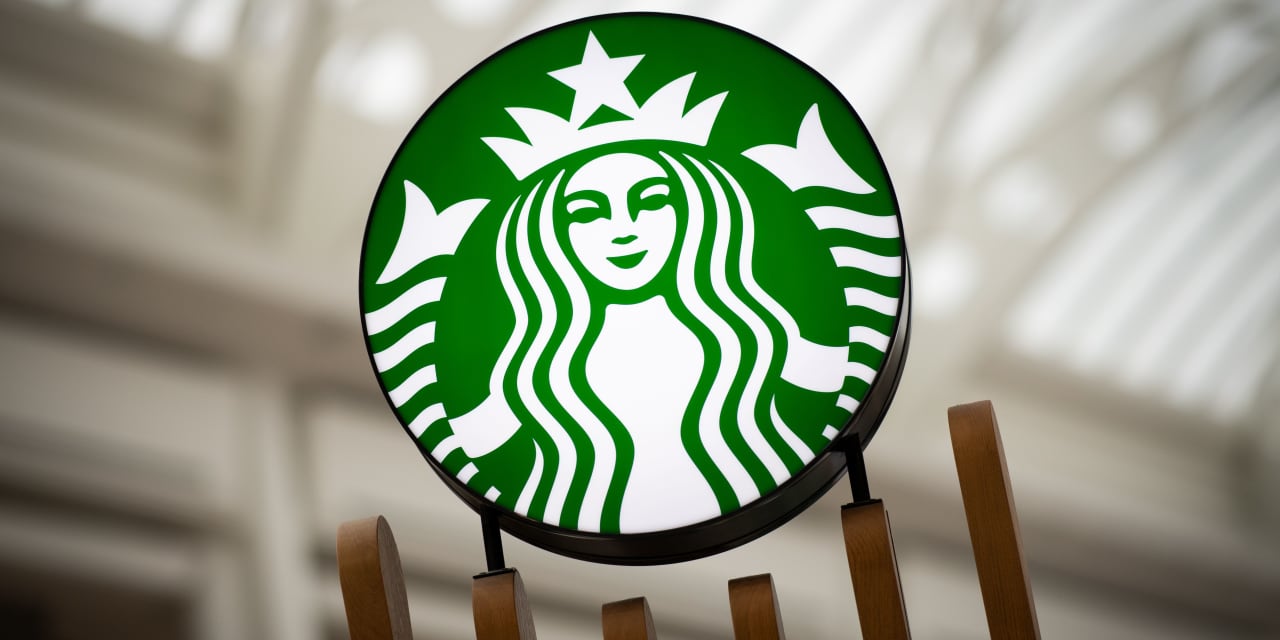When it rains, it pours. And it rained pretty heavily on
Starbucks
in the last leg of the year, prompting the company to miss earnings and revenue expectations for its fiscal first quarter.
Starbucks posted adjusted earnings of 90 cents a share, below expectations for 93 cents a share, according to FactSet.
Sales rose 8% year over year to a record $9.4 billion, but fell short of consensus estimates for $9.6 billion. Same-store sales rose by 5%, below expectations for 7.1%.
“Despite headwinds, our brand is very strong, and that coupled with innovation and a relentless focus on our green apron partners form long-term differentiators, along with focused execution on Triple Shot Reinvention, will drive balanced and attractive earnings growth,” said CEO Laxman Narasimhan.
Narasimhan plans to address some of the challenges facing the company in a call with investors scheduled for 5 p.m. Eastern. Management will also provide guidance for fiscal 2024 during the call.
Earnings haven’t fallen short of expectations in the past three fiscal quarters, but many analysts were bracing themselves for disappointment this time around. In the past month, the consensus forecasts for earnings and sales declined by 2.6% and 1.1%, respectively, according to FactSet.
The past couple of months have given skeptics on the stock plenty of reason for confidence. From early October to Jan. 1, Starbucks stock has gained 5.4%, underperforming the S&P 500’s 11% gain during the same period. At one point during the quarter, the stock went through a 12-day losing streak that wiped out more than $10 billion in market capitalization.
In October, the company came under heat for its response to the Israel-Hamas war, prompting boycott calls from both sides of the conflict. A month later, some of the company’s unionized stores went on strike. And in December, a third-party report—commissioned by Starbucks in response to shareholder pressure—found that while the company didn’t purposely engage in an antiunion campaign, it had bungled its response to the rise in union activity, resulting in “significant” negative consequences.
Controversy aside, bears also pointed to the fact that growth in China, Starbucks’ second-largest market, may be stalling.
“Starbucks faces a more difficult environment in China, where depressed consumer confidence and deflationary pressures have enabled lower-cost competitors like Luckin Coffee to gain share,” said Rachel Wolff, senior analyst at Insider Intelligence.
Same-store sales in China grew by 10% this quarter, driven by a 21% increase in transactions.
A majority of analysts have their doubts about the stock: 62% rate the stock at Hold or the equivalent, while 38% have it at Buy.
On their end, the bulls say the pessimism presents an opportunity.
Wells Fargo’s
Zachary Fadem believes the stock’s lower valuation has improved the balance between risks and potential rewards.
“A SBUX miss seems priced in & we like the ‘24 setup from here,” he wrote in a note last week. Starbucks is one of his top picks for the coming earnings season. He rates it Overweight with a $105 target.
And indeed, the market seemed to side with Fadem on Tuesday. The stock was up 2.6% to $96.63 in after-hour trading.
Bolstering the bull case may be the fact that the company’s adjusted operating margin grew 1.4 percentage points from a year earlier to 15.8%. The gains were driven by operational efficiencies Starbucks has achieved via a multiyear Reinvention Plan, such as equipment innovation and scheduling improvements, the company said.
Starbucks’ loyalty program is also still going strong. The number of active members jumping 13% from a year earlier to 34.3 million. Rewards members visited their local cafes more often and spent a record amount this quarter, the company said.
Write to Sabrina Escobar at [email protected]
Read the full article here




